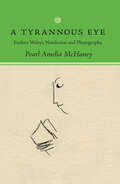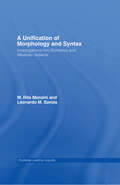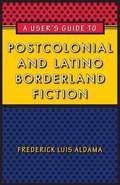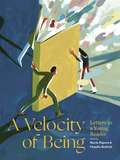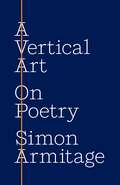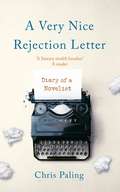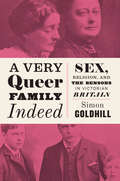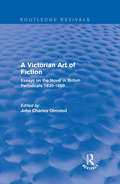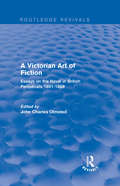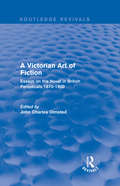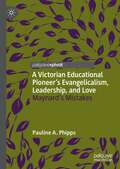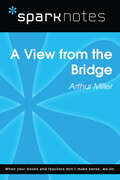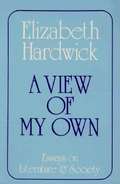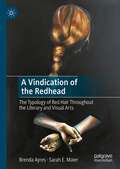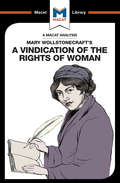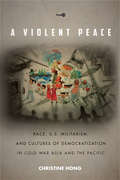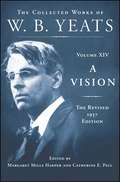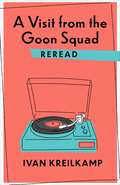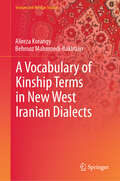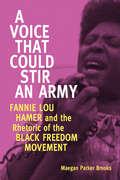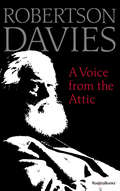- Table View
- List View
A Tyrannous Eye: Eudora Welty's Nonfiction and Photographs
by Pearl Amelia McHaneyA Tyrannous Eye: Eudora Welty’s Nonfiction and Photographs is the first book-length study of Eudora Welty’s full range of achievements in nonfiction and photography. A preeminent Welty scholar, Pearl Amelia McHaney offers clear-eyed and complex assessments of Welty’s journalism, book reviews, letters, essays, autobiography, and photographs. Each chapter focuses on one genre, filling in gaps left by previous books. With keen skills of observation, finely tuned senses, intellect, wit, awareness of audience, and modesty, Welty applied her genius in all that she did, holding a tough line on truth, breaking through “the veil of indifference to each other’s presence, each other’s wonder, each other’s plight.” McHaney’s study brings critical attention to the under-evaluated genres of Welty’s work and discusses the purposeful use of arguments, examples, and styles, demonstrating that Welty pursued her craft to a high standard across genres with a greater awareness of context than she admitted in her numerous interviews. Welty consistently dared new styles, new audiences, and new publishing venues in order to express her ideas to their fullest. It is “serious daring,” as she wrote in One Writer’s Beginnings, that makes for great writing. In “Place in Fiction,” Welty asks, “How can you go out on a limb if you do not know your own tree? No art ever came out of not risking your neck. And risk—experiment—is a considerable part of the joy of doing.”
A Unification of Morphology and Syntax: Investigations into Romance and Albanian Dialects (Routledge Leading Linguists)
by M. Rita Manzini Leonardo M. SavoiaThis highly original and innovative analysis focuses on the morphosyntax of dialects comprising Italy, Corsica and the Italian and Romansch-speaking areas of Switzerland. The empirical base used in the book includes a wealth of previously unknown or understudied data from a variety of Romansch dialects, whilst the theoretical framework is extremely sophisticated and up-to-date. Linguists of all genres will be fascinated by Manzini and Savoia’s radical conclusion: they claim that their work suggests a unification of morphology and syntax.
A User's Guide to Melancholy
by Mary Ann LundA User's Guide to Melancholy takes Robert Burton's encyclopaedic masterpiece The Anatomy of Melancholy (first published in 1621) as a guide to one of the most perplexing, elusive, attractive, and afflicting diseases of the Renaissance. Burton's Anatomy is perhaps the largest, strangest, and most unwieldy self-help book ever written. Engaging with the rich cultural and literary framework of melancholy, this book traces its causes, symptoms, and cures through Burton's writing. Each chapter starts with a case study of melancholy - from the man who was afraid to urinate in case he drowned his town to the girl who purged a live eel - as a way into exploring the many facets of this mental affliction. A User's Guide to Melancholy presents in an accessible and illustrated format the colourful variety of Renaissance melancholy, and contributes to contemporary discussions about wellbeing by revealing the earlier history of mental health conditions.
A User's Guide to Postcolonial and Latino Borderland Fiction
by Frederick Luis AldamaWhy are so many people attracted to narrative fiction? How do authors in this genre reframe experiences, people, and environments anchored to the real world without duplicating "real life"? In which ways does fiction differ from reality? What might fictional narrative and reality have in common--if anything? By analyzing novels such as Arundhati Roy's The God of Small Things, Amitav Ghosh's The Glass Palace, Zadie Smith's White Teeth, and Hari Kunzru's The Impressionist, along with selected Latino comic books and short fiction, this book explores the peculiarities of the production and reception of postcolonial and Latino borderland fiction. Frederick Luis Aldama uses tools from disciplines such as film studies and cognitive science that allow the reader to establish how a fictional narrative is built, how it functions, and how it defines the boundaries of concepts that appear susceptible to limitless interpretations. Aldama emphasizes how postcolonial and Latino borderland narrative fiction authors and artists use narrative devices to create their aesthetic blueprints in ways that loosely guide their readers' imagination and emotion. In A User's Guide to Postcolonial and Latino Borderland Fiction, he argues that the study of ethnic-identified narrative fiction must acknowledge its active engagement with world narrative fictional genres, storytelling modes, and techniques, as well as the way such fictions work to move their audiences.
A Velocity Of Being: Letter To A Young Reader
by David Remnick Maria Popova Claudia BedrickIn these pages, some of today's most wonderful culture-makers--writers, artists, scientists, entrepreneurs, and philosophers--reflect on the joys of reading, how books broaden and deepen human experience, and the ways in which the written word has formed their own character. On the page facing each letter, an illustration by a celebrated illustrator or graphic artist presents that artist's visual response. Among the diverse contributions are letters from Jane Goodall, Neil Gaiman, Jerome Bruner, Shonda Rhimes, Ursula K. Le Guin, Yo-Yo Ma, Judy Blume, Lena Dunham, Elizabeth Gilbert, and Jacqueline Woodson, as well as a ninety-eight-year-old Holocaust survivor, a pioneering oceanographer, and Italy's first woman in space. Some of the illustrators, cartoonists, and graphic designers involved are Marianne Dubuc, Sean Qualls, Oliver Jeffers, Maira Kalman, Mo Willems, Isabelle Arsenault, Chris Ware,Liniers, Shaun Tan, Tomi Ungerer, and Art Spiegelman.
A Vertical Art: On Poetry
by Simon ArmitageFrom the UK Poet Laureate and bestselling translator, a spirited book that demystifies and celebrates the art of poetry todayIn A Vertical Art, acclaimed poet Simon Armitage takes a refreshingly common-sense approach to an art form that can easily lend itself to grand statements and hollow gestures. Questioning both the facile and obscure ends of the poetry spectrum, he offers sparkling new insights about poetry and an array of favorite poets.Based on Armitage’s public lectures as Oxford Professor of Poetry, A Vertical Art illuminates poets as varied as Emily Dickinson, Walt Whitman, Marianne Moore, W. H. Auden, Ted Hughes, Thom Gunn, A. R. Ammons, and Claudia Rankine. The chapters are often delightfully sassy in their treatment, as in “Like, Elizabeth Bishop,” in which Armitage dissects—and tallies—the poet’s predilection for similes. He discusses Bob Dylan’s Nobel Prize, poetic lists, poetry and the underworld, and the dilemmas of translating Sir Gawain and the Green Knight. Armitage also pulls back the curtain on the unromantic realities of making a living as a contemporary poet, and ends the book with his own list of “Ninety-Five Theses” on the principles and practice of poetry.An appealingly personal book that explores the volatile and disputed definitions of poetry from the viewpoint of a practicing writer and dedicated reader, A Vertical Art makes an insightful and entertaining case for the power and potential of poetry today.
A Very Close Conspiracy: Vanessa Bell and Virginia Woolf
by Jane DunnThe lives of Virginia Woolf and her sister, Vanessa Bell, embodied opposites of human nature. The former was dedicated to the life of the mind and imagination, the latter to sensual experience. This book shows how the two sisters developed and enriched each other's lives.
A Very Nice Rejection Letter: Diary of a Novelist
by Chris Paling'Like all good diarists Paling's musings are funny, tender and uncensored' Sunday Times6 April 2007Writing income for the year so far: minus £300'I feel that this might just be the year in which something happens. Then again it might not. But hope drives all writers on.'It's unlikely that you'll know Chris Paling's face or have heard his name. This is his diary of trying to make a living as a writer, through the typical career trajectory of what is deemed a 'mid-list novelist'. Publishing rule 6: there is no such thing as a 'low-list' novelist.In renumeration terms, writing is a career that often ends in disappointment and despair, and occasionally disgrace. Paling artfully explores what compels him and so many others to write - the battling joys and agonies of when that compulsion beds itself in one's psyche, and a day without writing is a day wasted. A fascinating insight into the writing process, he tracks the need to write something new, or something old in a new way, something relevant, something that needs to be written when very little actually does, in search of that ever-elusive goal of being 'in print'.By turns moving, wry and brutally honest, A Very Nice Rejection Letter unveils the rewarding yet soul-baring life of a novelist. At its heart is a love letter to the art of writing but this delightful book is also a profound reflection on the forces that drive us all.
A Very Queer Family Indeed: Sex, Religion, and the Bensons in Victorian Britain
by Simon Goldhill“We can begin with a kiss, though this will not turn out to be a love story, at least not a love story of anything like the usual kind.” So begins A Very Queer Family Indeed, which introduces us to the extraordinary Benson family. Edward White Benson became Archbishop of Canterbury at the height of Queen Victoria’s reign, while his wife, Mary, was renowned for her wit and charm—the prime minister once wondered whether she was “the cleverest woman in England or in Europe.” The couple’s six precocious children included E. F. Benson, celebrated creator of the Mapp and Lucia novels, and Margaret Benson, the first published female Egyptologist. What interests Simon Goldhill most, however, is what went on behind the scenes, which was even more unusual than anyone could imagine. Inveterate writers, the Benson family spun out novels, essays, and thousands of letters that open stunning new perspectives—including what it might mean for an adult to kiss and propose marriage to a twelve-year-old girl, how religion in a family could support or destroy relationships, or how the death of a child could be celebrated. No other family has left such detailed records about their most intimate moments, and in these remarkable accounts, we see how family life and a family’s understanding of itself took shape during a time when psychoanalysis, scientific and historical challenges to religion, and new ways of thinking about society were developing. This is the story of the Bensons, but it is also more than that—it is the story of how society transitioned from the high Victorian period into modernity.
A Victorian Art of Fiction: Essays on the Novel in British Periodicals 1830-1850
by John Charles OlmstedFirst published in 1979, this collection of sixty-three essays on the novel drawn from ten periodicals demonstrates the primary concerns of those discussing the nature and purpose of prose fiction in the period from 1830 to 1850. The essays reflect what was thought and said about the art of fiction and reveal what journalists of these periodicals thought were the most urgent critical concerns facing the working reviewer. Including an introduction which assesses the issues raised by the best periodicals at the time, this anthology is designed to provide students of Victorian fiction and critical theory with a collection of essays on the art of fiction in a convenient and durable form.
A Victorian Art of Fiction: Essays on the Novel in British Periodicals 1851-1869
by John Charles OlmstedFirst published in 1979, this collection of thirty-three essays on the novel drawn from thirteen periodicals demonstrates the primary concerns of those discussing the nature and purpose of prose fiction in the period from 1851 to 1869. The essays reflect what was thought and said about the art of fiction and reveal what journalists of these periodicals thought were the most urgent critical concerns facing the working reviewer. This volume includes work by major mid-century reviewers such as David Masson, George Henry Lewes, Walter Bagehot, William Caldwell Roscoe, Richard Holt Hutton and Leslie Stephen. Including an introduction which assesses the issues raised by the best periodicals at the time, this anthology is designed to provide students of Victorian fiction and critical theory with a collection of essays on the art of fiction in a convenient and durable form.
A Victorian Art of Fiction: Essays on the Novel in British Periodicals 1870-1900
by John Charles OlmstedFirst published in 1979, this collection of thirty-nine essays on the novel drawn from seventeen periodicals demonstrates the primary concerns of those discussing the nature and purpose of prose fiction in the period from 1870 to 1900. The essays reflect what was thought and said about the art of fiction and reveal what journalists of these periodicals thought were the most urgent critical concerns facing the working reviewer. Including an introduction which assesses the issues raised by the best periodicals at the time, this anthology is designed to provide students of Victorian fiction and critical theory with a collection of essays on the art of fiction in a convenient and durable form.
A Victorian Educational Pioneer’s Evangelicalism, Leadership, and Love: Maynard’s Mistakes
by Pauline A. PhippsThis book examines the relatively unknown English late-Victorian educational pioneer, Constance Louisa Maynard (1849-1935), whose innovative London-based Westfield College produced the first female BAs in the mid-1880s. An atypical and powerful woman, Maynard is also notable for her unique knowledge of psychology and patriotic Evangelicalism, both of which profoundly shaped her ambitions and passions. In contrast to most history about an individual’s life, this book builds a fascinating life story based upon evidence and clues from minutia. The focus is on nine enigmatic actions motivated by Maynard in her quests for educational leadership, global conversion, and same-sex love. Maynard’s acts that she called “mistakes,” caused deep enmities with administrators and college women. Yet amid her trials and conflicts Maynard made key decisions about her public and private life. Moreover, her so-called mistakes reveal astonishing new insights into a past mindset and the rapidly changing world in which Maynard lived.
A View from the Bridge (SparkNotes Literature Guide Series)
by SparkNotesA View from the Bridge (SparkNotes Literature Guide) by Arthur Miller Making the reading experience fun! Created by Harvard students for students everywhere, SparkNotes is a new breed of study guide: smarter, better, faster. Geared to what today's students need to know, SparkNotes provides: *Chapter-by-chapter analysis *Explanations of key themes, motifs, and symbols *A review quiz and essay topicsLively and accessible, these guides are perfect for late-night studying and writing papers
A View of My Own: Essays on Literature and Society
by Elizabeth Hardwick"A View of My Own: Essays on Literature and Society is renowned author Elizabeth Hardwick's insightful, sophisticated, witty, and often acerbic anthology of some of the essays she has written throughout her illustrious career.
A Vindication of the Redhead: The Typology of Red Hair Throughout the Literary and Visual Arts
by Brenda Ayres Sarah E. MaierA Vindication of the Redhead investigates red hair in literature, art, television, and film throughout Eastern and Western cultures. This study examines red hair as a signifier, perpetuated through stereotypes, myths, legends, and literary and visual representations. Brenda Ayres and Sarah E. Maier provide a history of attitudes held by hegemonic populations toward red-haired individuals, groups, and genders from antiquity to the present. Ayres and Maier explore such diverse topics as Judeo-Christian narratives of red hair, redheads in Pre-Raphaelite paintings, red hair and gender identity, famous literary redheads such as Anne of Green Gables and Pippi Longstocking, contemporary and Neo-Victorian representations of redheads from the Black Widow to The Girl with the Dragon Tattoo, and more. This book illuminates the symbolic significance and related ideologies of red hair constructed in mythic, religious, literary, and visual cultural discourse.
A Vindication of the Rights of Woman
by Ruth ScobieMary Wollstonecraft’s 1792 Vindication of the Rights of Women is an incendiary attack on the place of women in 18th-century society. Often considered to be the earliest widely-circulated work of feminism, the book is a powerful example of what can be achieved by creative thinkers – people who refuse to be bound by the standard ways of thinking, or to see things through the same lenses that everyone else uses. In the case of the Vindication, Wollstonecraft’s independent thinking went directly against the standard assumptions of the age regarding women. During the seventeenth century and earlier, it was an entirely standard point of view to consider women as, largely speaking, uneducable. They were widely considered to be men’s inferiors, incapable of rational thought. They not only did not need a rational education – it was assumed that they could not benefit from one. Wollstonecraft, in contrast, argued that women’s apparent triviality was a direct consequence of society failing to educate them. If they were not men’s equals, it was the fault of a society that refused to treat them as such. So radical was her message that it would take until the 20th century for her views to become truly accepted.
A Violent Peace: Race, U.S. Militarism, and Cultures of Democratization in Cold War Asia and the Pacific (Post*45)
by Christine HongA Violent Peace offers a radical cultural account of the midcentury transformation of the United States into a total-war state. As the Cold War turned hot in the Pacific, antifascist critique disclosed a continuity between U.S. police actions in Asia and a rising police state at home. Writers including James Baldwin, Ralph Ellison, and W.E.B. Du Bois discerned in U.S. domestic strategies to quell racial protests and urban riots the same logic of racial counterintelligence structuring America's devastating hot wars in Asia. Christine Hong examines the centrality of U.S. militarism to the Cold War cultural imagination. She assembles a transpacific archive—including war writings, Japanese accounts of the U.S. atomic bombing of Hiroshima, black radical human rights petitions, Korean War–era G.I. photographs, Filipino novels on guerrilla resistance, and Marshallese critiques of U.S. human radiation experiments—and places these materials alongside U.S. government documents to theorize these works as homologous responses to unchecked U.S. war and police power. In so doing, Hong shows how the so-called Pax Americana laid the grounds for solidarity—for imagining collective futures of total liberation.
A Vision: The Collected Works of W.B. Yeats Volume XIV
by William Butler Yeats Catherine E. Paul Margaret Mills HarperA new annotated edition of Yeats's indispensable, lifelong work of philosophy--a meditation on the connections between the imagination, history, and the metaphysical--this volume reveals the poet's greatest thoughts on the occult.First published in 1925, and then substantially revised by the author in 1937, A Vision is a unique work of literary modernism, and revelatory guide to Yeats's own poetry and thinking. Indispensable to an understanding of the poet's late work, and entrancing on its own merit, the book presents the "system" of philosophy, psychology, history, and the life of the soul that Yeats and his wife, George, received and created by means of mediumistic experiments from 1917 through the early 1920s. Yeats obsessively revised the original book that he wrote in 1925, and the 1937 version is the definitive version of what Yeats wanted to say. Now, presented in a scholarly edition for the first time by Yeats scholars Margaret Mills Harper and Catherine E. Paul, the 1937 version of A Vision is an important, essential literary resource and a must-have for all serious readers of Yeats.
A Visit from the Goon Squad Reread (Rereadings)
by Ivan KreilkampJennifer Egan described her Pulitzer Prize–winning novel A Visit from the Goon Squad as a combination of Proust and The Sopranos. In rereading the book, Ivan Kreilkamp takes Egan up on her comparison, showing how it blends a concern with the status of the novel in the twenty-first century with an elegiac meditation on how we experience the passage of time.Kreilkamp, a former music critic, examines how Egan’s characters turn to rock and especially punk in search of community and meaning. He considers what the novel’s portrayal of music says about the role of art in contemporary culture as digitization makes older technologies obsolete. Combining personal and critical reflection, he reveals how A Visit from the Goon Squad articulates and responds to the sense of loss many feel as cherished physical objects are replaced with immaterial data. For Kreilkamp, Egan’s novel compellingly combines the psychological realism of the nineteenth-century novel with more recent and transient forms such as the celebrity magazine profile or a PowerPoint presentation to provide a self-reflective diagnosis of the decay and endurance of literature.Arranged like Egan’s novel into A and B sides, this book highlights not only how A Visit from the Goon Squad speaks to our mass-media and digital present but also its page-turning pleasure.
A Visit to Gold Town (Rigby Leveled Library, Level K #31)
by Heather Hammonds Elizabeth BottéNIMAC-sourced textbook
A Vocabulary of Kinship Terms in New West Iranian Dialects (Iranian and Persian Studies)
by Alireza Korangy Behrooz Mahmoodi-BakhtiariThis book is the first of its kind in providing a lexicon of kinship terms prevalent in the Western dialects of Iran, with a parallel glossary in English. It engages the dialects and their terminology in the English language to bring to purview how language imitates life, particularly in rural settings. Subsequently, it gives a glimpse into the irrefutable relation that exists between culture and word usage. In doing so, it serves as a cultural manifesto as it pertains to Persian language, poetics, and applied linguistics and is relevant to linguists, cultural scholars, Anthropologists and students in Persian language, literature, and culture and certainly all Iranian languages.
A Voice Still Heard
by Irving Howe Morris Dickstein Nina HoweMan of letters, political critic, public intellectual, Irving Howe was one of America’s most exemplary and embattled writers. Since his death in 1993 at age 72, Howe’s work and his personal example of commitment to high principle, both literary and political, have had a vigorous afterlife. This posthumous and capacious collection includes twenty-six essays that originally appeared in such publications as the New York Review of Books, the New Republic, and the Nation. Taken together, they reveal the depth and breadth of Howe’s enthusiasms and range over politics, literature, Judaism, and the tumults of American society. A Voice Still Heard is essential to the understanding of the passionate and skeptical spirit of this lucid writer. The book forms a bridge between the two parallel enterprises of culture and politics. It shows how politics justifies itself by culture, and how the latter prompts the former. Howe’s voice is ever sharp, relentless, often scathingly funny, revealing Howe as that rarest of critics—a real reader and writer, one whose clarity of style is a result of his disciplined and candid mind.
A Voice That Could Stir an Army: Fannie Lou Hamer and the Rhetoric of the Black Freedom Movement (Race, Rhetoric, and Media Series)
by Maegan Parker BrooksA sharecropper, a warrior, and a truth-telling prophet, Fannie Lou Hamer (1917–1977) stands as a powerful symbol not only of the 1960s black freedom movement, but also of the enduring human struggle against oppression. A Voice That Could Stir an Army is a rhetorical biography that tells the story of Hamer's life by focusing on how she employed symbols—images, words, and even material objects such as the ballot, food, and clothing—to construct persuasive public personae, to influence audiences, and to effect social change. Drawing upon dozens of newly recovered Hamer texts and recent interviews with Hamer's friends, family, and fellow activists, Maegan Parker Brooks moves chronologically through Hamer's life. Brooks recounts Hamer's early influences, her intersection with the black freedom movement, and her rise to prominence at the 1964 Democratic National Convention. Brooks also considers Hamer's lesser-known contributions to the fight against poverty and to feminist politics before analyzing how Hamer is remembered posthumously. The book concludes by emphasizing what remains rhetorical about Hamer's biography, using the 2012 statue and museum dedication in Hamer's hometown of Ruleville, Mississippi, to examine the larger social, political, and historiographical implications of her legacy. The sustained consideration of Hamer's wide-ranging use of symbols and the reconstruction of her legacy provided within the pages of A Voice That Could Stir an Army enrich understanding of this key historical figure. This book also demonstrates how rhetorical analysis complements historical reconstruction to explain the dynamics of how social movements actually operate.
A Voice from the Attic
by Robertson DaviesA collection of essays &“filled with pleasantly rambling opinions about everything from self-help books to erotica&” from the celebrated Canadian author (The Chronicle Journal). An urbane, robust, and wonderfully opinionated voice from Canada, sometimes called &“America&’s attic,&” speaks here of the delights of reading, and of what mass education has done to readers today, to taste, to books, to culture. With his usual wit and breadth of vision, Robertson Davies ranges through the world of letters—books renowned and obscure, old and recent; English, Irish, Canadian, and American writers both forgotten and fondly remembered. &“Sweet reason in the raiment of well-woven prose? Most assuredly. Good humor agraze over broad literary demesnes? No doubt of it. Forgotten popular favorites rescued and rehabilitated? Certainly. A parade of agreeable prejudices? He would not be a true Canadian if he did not have them. Lightheartedness where needed? Yes. Seriousness where it counts? Yes. Wit, satirical touches, firm indignations, sound sense, good taste, judiciousness, cosmopolitan breadth of view, urbanity, sanity, unexpected eccentricities, educated humanism? By all means. It is indeed by all these means and more that this book of essays and observations bestows its multiple benefactions, and anyone picking it up is bound north to pleasure and profit.&”—The New York Times
